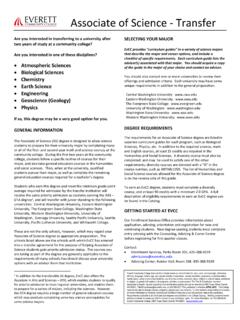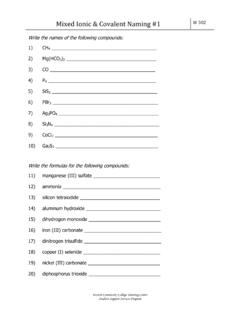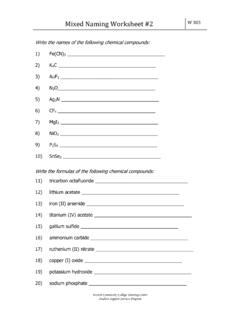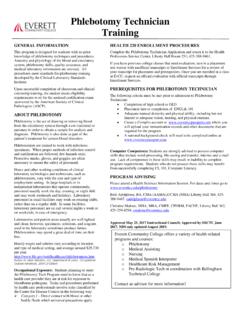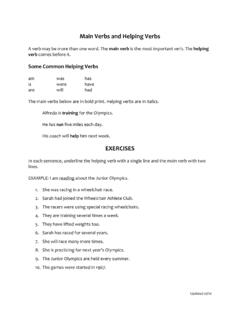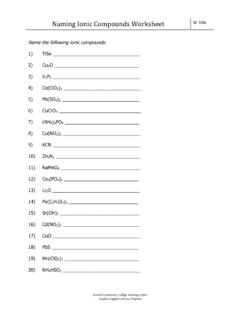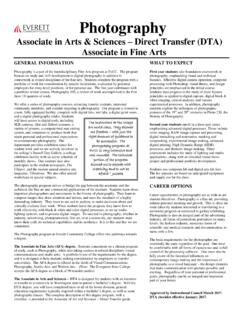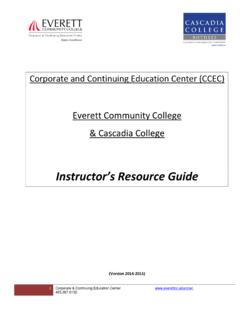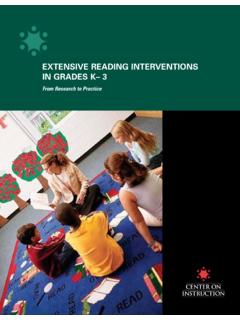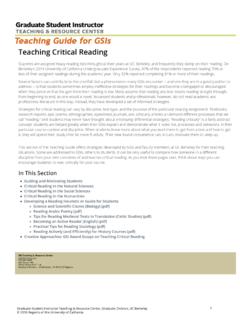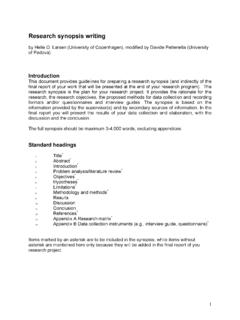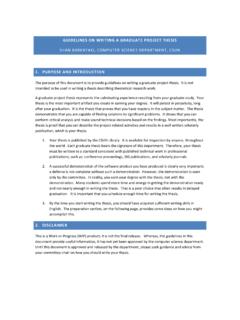Transcription of SYNOPSIS - Everett Community College
1 SYNOPSIS A SYNOPSIS is a summary. The purpose of a summary is to provide a shortened version of a given piece of writing. Most frequently a SYNOPSIS is a multi-paragraph summary of a chapter, book, article, or drama. It makes no effort to address every idea. The reader understands that a SYNOPSIS is necessarily subjective because the writer must select the items to be included. Thus, the SYNOPSIS reflects editorial bias. CHARACTERISTICS A SYNOPSIS generally Selects main ideas which, in the writer s opinion, best represent the original piece Reflects the style of the current writer, as opposed to the author of the original Gives sufficient details to clarify the main ideas Is sufficiently informative to aid further investigation Has a reporter s objectivity PROCESS Use the following process to develop a SYNOPSIS : PREWRITING Step 1.
2 reading the Material Quickly read the original passage without taking notes. Look for repeated themes and the general treatment of ideas. If unfamiliar names are difficult to you, you may want to list them for later reference, noting the correct spelling. Once you ve finished reading , jot down the three or four most important ideas. They will serve as the skeletal outline of your , you will not cover all the ideas in a SYNOPSIS . WRITING Step 2. Preparing the SYNOPSIS Begin the SYNOPSIS by identifying in a single sentence the main idea of the original. Weave the title and author into an early (though not necessarily the first) sentence. Follow with a brief description of the main ideas. Follow the organization of the original. Keep in mind that a SYNOPSIS will be short, maybe only a paragraph in length.
3 Deal only with essentials. REVISING Step 3. Improving the Content Your SYNOPSIS will almost invariably be too long. Begin cutting. Omit needless details. Shorten sentences. Use strong nouns and verbs in order to omit modifiers. Keep this challenge: If you had to summarize the original in a single sentence, what would you say? If you could add on more sentences, what would you say? Follow this progression until you have stated all the important ideas. PROOFREADING Step 4. Checking the Details Once you have completed the revision, check for spelling, punctuation, grammar, mechanics, and usage. Refer also to the dictionary, a thesaurus, and/or the spell check/grammar check for spelling and vocabulary problems. The steps above should enable you to develop a SYNOPSIS . Compare your own with the example below, and study the analysis which follows.
4 SAMPLE SYNOPSIS The following SYNOPSIS summarizes a novel of nearly 550 pages. Ice-Age Novel The second book of a trilogy, The Valley of the Horses, fictionalizes the beginning of civilization in the Asian area north of the Beran Sea. Like Jean M., Auel s other two books, The Clan of the Cave Bear and The Mammoth Hunters, this one gets its foundation from archaeological research supporting the evolution of man. In this unusual historical novel, the reader follows Ayla, a child of the Others who has been reared by the Clan of the Cave Bear only to be ejected from the Clan when she violates customs she cannot understand or accept. In exile in the Valley of the Horses, she survives five year alone until she meets Jondalar, a man of the Others. Ayla faces a lonely struggle for survival after her death curse by the Clan.
5 To solve basic survival problems, she must use logic: alone, how can she kill, butcher, and process an animal large enough to feed her through the severe winter; alone, how can she provide clothing, cooking utensils, sleeping skins, and shelter for protection; alone, how can she protect herself from the dangers around her? Her training as a medicine woman and her knowledge of hunting couples with the large brain characteristic of the Others allow her to succeed. Also, as a result of her background, she saves Jondalar s life after a lion mauls him and kills his traveling-companion brother. Jondalar is the first of the Others that Ayla has seen. After Ayla s medicinal powers help Jondalar regain his health, the two of them suffer from their inability to understand each other s customs.
6 Jondalar finally teaches her to speak, however, and they are able to establish a strong bond, sharing their creative ideas to find solutions for both the physical and psychological problems they face as a team. Analysis of the SYNOPSIS The sample SYNOPSIS illustrates most of the characteristics of a good SYNOPSIS : In two paragraphs, it summarizes a book of nearly 550 pages The introduction includes the name of the work and the author s name, both woven naturally into the single-statement summary The second sentence places the novel in its historical perspective, without adding details about the archaeological research, evolution, or the setting The third sentence introduces the main character and explains why she is in the Valley of the Horses. We are given no details about the Clan or the Others, but the labels are sufficiently suggestive for the purpose of a SYNOPSIS The second paragraph summarizes the plot and lists the problems facing Ayla.
7 By using the colon and a list, the author condenses chapter after chapter into a simple series Without explaining tempestuous, the writer alludes to problems facing Ayla and the male character, Jondalar Simple phrases like when Ayla interferes and after he regains his health summarize whole chapters Thus, the SYNOPSIS condenses the contents of a major work. The responsibility to select the most significant ideas weighs heavily on the writer. Compare your own SYNOPSIS with the one above. Think through the analysis. You should now be able to analyze your own SYNOPSIS as effectively.

